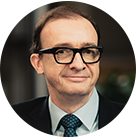
Outlook 2025: All change
The year ahead promises a different environment for financial investors, but it is clear earnings in many areas will improve and the global mood is positive.
Originally published November 20, 2024 by Fidelity International.
Written by Niamh Brodie-Machura, Co-Chief Investment Officer, and Andrew Wells, Head of Canada, Fidelity Canada
Highlights
- Raised odds for reflation
- Need for a flexible approach
- Continued stabilization for China
There is an inevitable divergence. William Fulbright noted at the height of the Cold War, between the world as it is and the world as man perceives it. For a long time over the past couple of decades, most of us at least agreed on the direction of its travel. That is no longer the case. But the resulting divergences in policies, economic performance and geopolitics present a strong range of opportunities for market participants in 2025.
Most prosaically, growth, inflation and interest rates across the world’s biggest economies are liable to head in very different directions in the months ahead, and there is now far more doubt about those paths. As our macro team lay out in their outlook, authorities in the U.S., China and Europe are liable to have very different concerns over the course of the year.
A landmark U.S. election result raises the odds of an outright reflation of the world’s biggest economy. We are mid- to late-cycle, and not at the end of the cycle, creating a volatile environment that should generally be good for risk assets, but puts a premium on getting investment choices right. Valuations of a number of past winners are elevated, but the mood in general is positive.
As companies and consumers find their way through the new landscape, our view on equities is that that reflation will boost earnings, easing fears about higher corporate valuations. A pro-business, pro-innovation administration should prove helpful, and lower interest rates should benefit capital-intensive industries and help cyclicals outperform. Optimism prevails in Japan and India.
Our multi-asset team has run through some of their top picks, recommending we look beyond the previous stars to patches of the market that have been neglected in the enthusiasm for AI and tech. They highlight U.S. mid-caps, and for thematic investors, future financials, for income investors, non-U.S. duration, collateralized loan obligations and short-dated high-yielding credit, and for drawdown-aware investors, absolute return strategies.
Fixed income investors, meanwhile, face tight spreads that are priced for benign economic conditions. With public sector deficits projected to expand, the prospect of tariffs and trade disputes and ongoing geopolitical tension, there is a case that less optimistic scenarios are being underpriced. This represents a potential source of value in credit markets.
We worry in general about the lack of a clear path to slow the growth of public debt over the course of the next four years. Stagflation may still yet be a threat. Politics likewise hang over a profoundly complex picture for currency markets. Donald Trump has said he would like a weaker dollar, but the market reading of his policy platform is that it will go in the opposite direction. We will see if that holds.
What China does on stimulus – and with its stock of U.S. Treasuries – looms large. A stabilizing Chinese economy is welcome news for Europe, but it will not lend enough strength to the continent to fully recover in the next 12 months, while the dollar is a crucial factor for emerging markets.
The need for a diversified portfolio to spread risk also makes the case for private assets. Going into 2025, with many markets still on the cusp of recovery, prices are low, and there are opportunities for investment that could deliver solid returns in the medium to long term.
In short, investors will need a flexible approach. Detailed, deep research into the businesses and markets they invest in will be at a premium. Divergence, as Fulbright said, is inevitable – and this year it will pay to watch the differences.
Issued by Fidelity Investments Canada ULC (“FIC”). Unless otherwise stated, all views expressed are those of Fidelity International, which cts as a subadvisor in respect of certain FIC institutional investment products or mandates.
These materials may contain statements that are “forward-looking statements,” which are based on certain assumptions of future events. Forward- looking statements are based on information available on the date hereof, and Fidelity Investments Canada ULC (“FIC”) does not assume any duty to update any forward-looking statement. Actual events may differ from those assumed by FIC when developing forward-looking statements. There can be no assurance that forward-looking statements, including any projected returns, will materialize or that actual market conditions and/ or performance results will not be materially different or worse than those presented.
This document does not constitute a distribution, an offer or solicitation to engage the investment management services of Fidelity, or an offer to buy or sell or the solicitation of any offer to buy or sell any securities in any jurisdiction or country where such distribution or offer is not authorized or would be contrary to local laws or regulations. Fidelity makes no representations that the contents are appropriate for use in all locations or that the transactions or services discussed are available or appropriate for sale or use in all jurisdictions or countries or by all investors or counterparties.
This communication is not directed at and must not be acted on by persons inside the U.S. and is otherwise only directed at persons residing in jurisdictions where the relevant funds are authorized for distribution or where no such authorization is required. Fidelity is not authorized to manage or distribute investment funds or products in, or to provide investment management or advisory services to persons resident in, mainland China. All persons and entities accessing the information do so on their own initiative and are responsible for compliance with applicable local laws and regulations and should consult their professional advisors.
Reference in this document to specific securities should not be interpreted as a recommendation to buy or sell these securities but is included for the purposes of illustration only. Investors should also note that the views expressed may no longer be current and may have already been acted upon by Fidelity. The research and analysis used in this documentation is gathered by Fidelity for its use as an investment manager and may have already been acted upon for its own purposes. This material was created by Fidelity International.
This article has been provided by Fidelity Investments Canada ULC (Fidelity) and is for information purposes only. Past performance is not a reliable indicator of future results.
This document may contain materials from third parties which are supplied by companies that are not affiliated with any Fidelity entity (third-party content). Fidelity has not been involved in the preparation, adoption or editing of such third-party materials and does not explicitly or implicitly endorse or approve such content.
Fidelity International refers to the group of companies which form the global investment management organization that provides products and services in designated jurisdictions outside of North America. Fidelity, Fidelity International, the Fidelity International logo and F symbol are trademarks of FIL Limited. Fidelity only offers information on products and services and does not provide investment advice based on individual circumstances.



